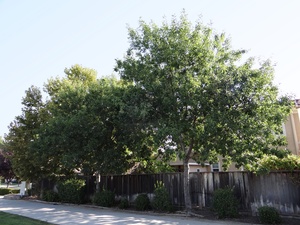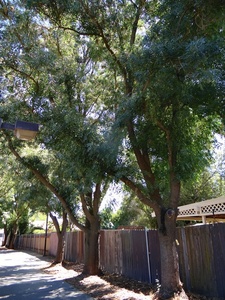Ash Trees are trees in the Fraxinus genus of the olive family. Fringe trees, olive trees, and privets are also members of the olive family. There are about 45 to 65 ash tree species.
One ash tree species is native to Woodland, and two others are native to Yolo County. Three non-native species are commonly planted by the City of Woodland in our parks and on our streets. Ash Drive in eastern Woodland is named for our local ash trees—most likely the native ones.
The Emerald Ash Borer (Agrilus planipennis), a green beetle native to Asia, is an invasive species that was accidentally brought to the east coast of the United States in the 1990s and has since been spreading westward, threatening to kill the vast majority of the 7.5 billion ash trees in the United States. It has not yet been found further west than Colorado, but it likely will be. All North American ash species are highly susceptible to it. An infested tree can be recognized by premature fall color on affected branches in August or September, upper crown dieback, epicormic shoots or sprouts, bark lesions, and deformed exit holes. The emerald ash borer is also capable of infesting Fringe Trees and Olive Trees, but this does not seem to be common.
Native to Woodland
Oregon Ash (Fraxinus latifolia) is a deciduous tree native to Woodland, Davis, West Sacramento, and the entire area in between them; as well as the northern slopes of the Dunnigan Hills and the entire portion of Yolo County north of them; and also the Yolo County foothills, including the Capay Hills. It usually grows 40 to 80 feet tall and up to 30 feet wide. It has a lifespan of 250 years and is fast-growing, especially when young. It prefers full sun or partial shade and poor drainage. Oregon Ash trees are either male or female, so they do not produce seedlings unless there are both male and female trees in the area.
Native to Yolo County
Flowering Ash (Fraxinus dipetala), also called Two-Petal Ash or California Ash, is a deciduous shrub native to the Yolo County foothills, including the Capay Hills, extending very slightly into the Sacramento Valley south of Esparto. It grows to about 25 feet tall and about 15 feet wide. It prefers full sun or partial shade and has very low water needs. Male and female flowers are borne on the same plant. Flowering Ash is ranked 4 out of 10 on the Ogren Plant Allergy Scale, indicating that it is a fairly safe choice for hay fever sufferers.
 A row of three Modesto Ash (Fraxinus velutina) trees in Spring Lake Alley next to Jack Slaven Park.Modesto Ash (Fraxinus velutina), also called Arizona Ash or Velvet Ash, is a deciduous tree native to a small patch of land in eastern Winters. It usually grows 30 to 40 feet tall. It prefers full sun or partial shade and good drainage. Modesto Ash trees are either male or female, so they do not produce seedlings unless there are both male and female trees in the area. Only the male trees produce pollen, but the male trees are ranked 7 out of 10 on the Ogren Plant Allergy Scale, indicating a tendency to cause fairly severe hay fever. It typically blooms in May and June, so if you suffer from hay fever during those months, a male Modesto Ash could be the culprit. Modesto Ash is planted in Jack Slaven Park, Joseph Schneider Park, and Woodland City Cemetery. It is also planted as a street tree on 1st Street, 2nd Street, 3rd Street, 4th Street, 5th Street, Beamer Street, Clanton Way, Cleveland Street, Clover Street, College Street, Court Street, Cross Street, Depot Street, East Gum Avenue, Elliot Street, Elm Street, Grand Avenue, Johnston Street, Marshall Avenue, McKinley Avenue, Pendegast Street, Pershing Avenue, and Sutter Street.
A row of three Modesto Ash (Fraxinus velutina) trees in Spring Lake Alley next to Jack Slaven Park.Modesto Ash (Fraxinus velutina), also called Arizona Ash or Velvet Ash, is a deciduous tree native to a small patch of land in eastern Winters. It usually grows 30 to 40 feet tall. It prefers full sun or partial shade and good drainage. Modesto Ash trees are either male or female, so they do not produce seedlings unless there are both male and female trees in the area. Only the male trees produce pollen, but the male trees are ranked 7 out of 10 on the Ogren Plant Allergy Scale, indicating a tendency to cause fairly severe hay fever. It typically blooms in May and June, so if you suffer from hay fever during those months, a male Modesto Ash could be the culprit. Modesto Ash is planted in Jack Slaven Park, Joseph Schneider Park, and Woodland City Cemetery. It is also planted as a street tree on 1st Street, 2nd Street, 3rd Street, 4th Street, 5th Street, Beamer Street, Clanton Way, Cleveland Street, Clover Street, College Street, Court Street, Cross Street, Depot Street, East Gum Avenue, Elliot Street, Elm Street, Grand Avenue, Johnston Street, Marshall Avenue, McKinley Avenue, Pendegast Street, Pershing Avenue, and Sutter Street.
Non-Native
White Ash (Fraxinus americana) is a deciduous tree from eastern and central North America. It usually grows 60 to 90 feet tall but can occasionally reach 120 feet tall. In 20 years, it might grow to 40 feet tall. It prefers full sun. It has high water needs and low drought tolerance but also prefers good drainage, so it usually does not grow in wetlands. White Ash trees are either male or female, so they do not produce seedlings unless there are both male and female trees in the area. Only the male trees produce pollen, but the male trees are ranked 7 out of 10 on the Ogren Plant Allergy Scale, indicating a tendency to cause fairly severe hay fever. American Ash typically blooms in April and May, so if you suffer from hay fever during those months, a male White Ash could be the culprit. White Ash is planted in Dave Douglass Park, Everman Park, and Woodland City Cemetery. It is also planted as a street tree on 2nd Street, 3rd Street, Cross Street, Depot Street, East Gibson Road, and Elm Street.
Narrowleaf Ash (Fraxinus angustifolia ssp. oxycarpa) is a deciduous tree from the Mediterranean region. It usually grows 70 to 100 feet tall. Its flowers can be male or "perfect" (having both male and female parts); all Narrowleaf Ash trees have both types of flowers. Narrowleaf Ash is ranked 1 out of 10 on the Ogren Plant Allergy Scale, indicating that it is the safest possible choice for hay fever sufferers. The 'Raywood' cultivar usually grows 40 to 50 feet tall and 25 feet wide, with red fall color. The 'Raywood' cultivar of Narrowleaf Ash is planted in Ralph Harris Park and William Crawford, Sr., Park. It is also planted as a street tree on 1st Street, 2nd Street, 3rd Street, Elliot Street, Elm Street, North College Street, North Street, Pheasant Court, and Walnut Street.
 A row of Green Ash (Fraxinus pennsylvanica) trees in East Schneider Alley at Joseph Schneider Park.Green Ash (Fraxinus pennsylvanica), also called Red Ash, is a fast-growing deciduous tree from eastern and central North America. It usually grows 40 to 80 feet tall. In 20 years, it might grow to 35 feet tall. It usually grows in wetlands. Green Ash trees are either male or female, so they do not produce seedlings unless there are both male and female trees in the area. Only the male trees produce pollen, but the male trees are ranked 7 out of 10 on the Ogren Plant Allergy Scale, indicating a tendency to cause fairly severe hay fever. Green Ash typically blooms in April and May, so if you suffer from hay fever during those months, a male Green Ash could be the culprit. Green Ash is planted in Joseph Schneider Park.
A row of Green Ash (Fraxinus pennsylvanica) trees in East Schneider Alley at Joseph Schneider Park.Green Ash (Fraxinus pennsylvanica), also called Red Ash, is a fast-growing deciduous tree from eastern and central North America. It usually grows 40 to 80 feet tall. In 20 years, it might grow to 35 feet tall. It usually grows in wetlands. Green Ash trees are either male or female, so they do not produce seedlings unless there are both male and female trees in the area. Only the male trees produce pollen, but the male trees are ranked 7 out of 10 on the Ogren Plant Allergy Scale, indicating a tendency to cause fairly severe hay fever. Green Ash typically blooms in April and May, so if you suffer from hay fever during those months, a male Green Ash could be the culprit. Green Ash is planted in Joseph Schneider Park.


